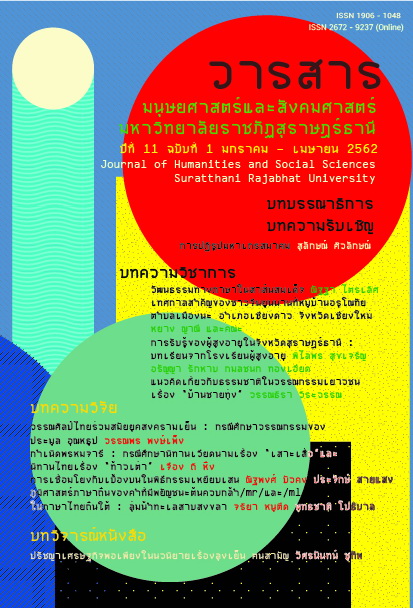Language Culture in SAN SOMDEJ
Main Article Content
Abstract
This academic paper considers an exchange of letters between two Thai princes, Prince Damrongrajanubhab and Prince Narisaranuvadtivong, between 1932 - 1943, and uses this exchange to illustrate etymological features of the Thai language during the years leading up to the Second World War. The princes communicate through an idiosyncratic, hybrid language, referred to here as their language culture. Their language culture embodies two interesting and rather unique features. First, it provides a window into how the Thai language was evolving and changing during the period under consideration, and second, it shows the role that English loan words came to play in influencing this change. The results of the discourse analysis performed on the texts show how the changes manifested themselves in four principal ways: (1) the use of apostrophes for separating and emphasizing Pali and Sanskrit words; (2) variation in the number of consonants found surrounding vowels; (3) differences in modern day spellings through the omission of the contemporary short vowel marker or Maitaikhu ( ็) , and (4) a textual style that resembles and predates the refrains often encountered in today's karaoke music. Of particular interest is how borrowed words, particularly English words, were transformed in various ways both in terms of their orthography and their semantic denotative and connotative meanings. While some words retained their original English spellings, others were transliterated into Thai. Likewise, in terms of meaning some borrowed words maintained their original meanings while others were subject to either restrictive specificity or semantic expansion. Altogether, the princes' letters provide a remarkable glimpse into a fascinating period when the Thai language was undergoing considerable change.
Article Details

This work is licensed under a Creative Commons Attribution-NonCommercial-NoDerivatives 4.0 International License.
All published manuscripts have been verified by peer-peer professors in the fields of humanities and social sciences. Reprinting of the article must be authorized by the editorial staff.
References
Amara Prasithrathsint. (1982). Characteristics of language borrowing and foreign culture appearing in Thai language.Arts of Language. 2(1), 63 - 78. (In Thai).
Amara Prasithrathsint. . (1999). Language in Thai Society: Variety, Changing, and development (2nded). Bangkok: Chulalongkorn University Publisher. (In Thai)
Journal of Humanities and Social Sciences, Vol. 11(1)
วารสารมนุษยศาสตร์และสังคมศาสตร์. (2004). Thai Language with English touching as seen on his royal rescript of King Chulalongkorn. Journal of Arts. 33(1), 48-68. (In Thai)Akekarat Udumporn. (2010).
The King suggests how to use Thai language. Bangkok: Patthanasueksa Publisher. (In Thai)
Bunchop Phanthumatha. (2003). Foreign Languages in the Thai Language. Bangkok: Ramkhamhaeng University. (In Thai)Dussadeepron Chamnirokhasan. (1983). historical linguistics. Bangkok: Chulalongkorn University. (In Thai)
Jiraporn Chottiarawong. (2001). Message of Princes: Attitude of “Foreign Language in Thai Language”. Liberal Arts Journal. 1(2), 47 - 67. (In Thai)Lakkhana Prompan. (2011). Western language loan words in Thai novels. Liberal Arts Master’s Thesis. Bangkok: Kasetsart University. (In Thai)
Merriam - Webster, Inc. (2015). Merriam-Webster Online Dictionary. [Online] Retrieved from http://www.merriam-webster.com/dictionary. [2018, Jul 20]. (In Thai) Nittaya Niratrob. (1987). English loan words in Thai language between B.E. 2417 - 2453. Liberal Arts Master’s Thesis. Bangkok: Thammasart University. (In Thai)
Prakat Watcharaporn. (2002). Global Thai Culturalist (2nded). Bangkok: Dokya Publisher 2000. (In Thai)
Pranee Kullawanich; ed al. (2001). Language Scene (5thed). Bangkok: Scholarly works published project, Faculty of Arts Chulalongkorn University. (In Thai)
Prapaporn Thanakittikasame. (1999). Traditions of San Somdej. Liberal Arts Master’s Thesis. Phitsanulok: Naresuan University. (In Thai)Praphoj Atsawawirunhakarn. (2012). Declamation on Pillars of the land; the Prince Damrong Rajanubhab Series; Message of Princes. [Online]. Retrieved from https://www.youtube.com/watch?v=mEOdZXtWBqg [2018, Aug 5]. (In Thai)
วารสารมนุษยศาสตร์และสังคมศาสตร์วัฒนธรรมทางภาษาในสาสนสมเด็จPrince of Phraya Narisaranuwattiwong Foundation, Krom Phraya Damrong Rajanubha Foundation and Kurusapha
Trade Organization (Collector). (2003). Message of Princes. Bangkok: Kurusapha Ladpraw Publisher. (In Thai)Rattana Chantao. (2001). Language Touching: Thai Language and Lao Language of Laotian. Lumnamkhong Journal. 7(3), 121 - 134. (In Thai)
Supapron Kongsirirat. (2010). A study of Worldview of King Chulalongkorn as seen on his royal rescript. Doctor of Education Thesis. Pitsanulok: Naresuan University. (In Thai)
Thitirat Raksasri. (2008). Western language vocabulary in Thai language dictionary, Royal Institute printed B.E. 2542. Liberal Arts Master’s Thesis. Pitsanulok: Naresuan University. (In Thai)
Thongsuk Ketroj. (2003). Foreign language in Thai Langauge (8thed). Bangkok: Ramkamheng University Publisher. (In Thai)
Unchalee Singhanoi. (2005). Universal Uniqueness and Identity of language and culture: Facilities and barrier in language touching. [Online]. Retrieved from http://www.human.nu.ac.th/jhnu/file/journal/ 2011_02_17_14_03_32-2-1-1.pdf [2018, Oct 5]. (In Thai)
Wanlaya Wimookthalob. (1970). Change the meaning of words, Phrase and order of words in Rattanakosin period. Master of Arts Thesis. Thai Language Department. Bangkok: Chulalongkorn University. (In Thai)
Wilaiwan Kanitthanan. (1983). Historical linguistics: Evolution of Thai and English. Bangkok: Thammasart University Publisher. (In Thai)
Wit Thiengburanatham. (2008). English-Thai Dictionary & Thai-English Dictionary Updated and Completely Edition. Bangkok: SE-EDUCATION.(In Thai)


